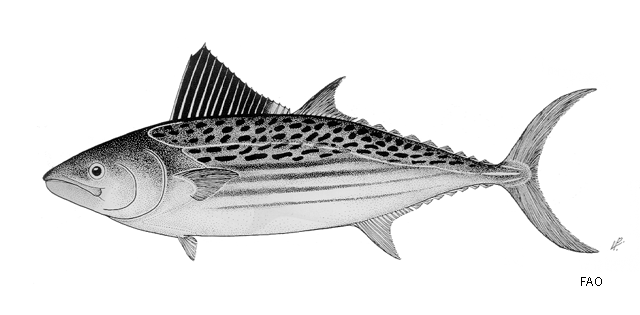| Scombridae (Mackerels, tunas, bonitos), subfamily: Scombrinae |
| 45 cm FL (male/unsexed); max.weight: 2,000.0 g |
|
pelagic-neritic; depth range - 50 m, oceanodromous |
| Western Pacific: restricted to the northern three quarters of Australia (absent from the south coast) and the southern coast of Papua New Guinea. |
|
Dorsal spines (total): 16-18; Dorsal soft rays (total): 17-19; Anal spines: 0-0; Anal soft rays: 15-17; Vertebrae: 45-50. Mouth rather large, upper jaw reaching to hind margin of eye. Laminae of olfactory rosette 28 to 33. Interpelvic process small and bifid. Body mostly naked behind the well developed corselet except for a band of scales along the bases of dorsal and anal fins and patches around the bases of the pectoral and pelvic fins. Swim bladder absent. The back is deep blue, covered with elongate black spots; the belly is light with several stripes like those of the skipjack tuna. |
| An epipelagic, neritic species that forms schools of several hundred individuals. Taken as bait for snappers by commercial fishers, and for marlins and sharks by sport fishers. Its meat is white and dry and is good when smoked or served steamed with moderately flavored white sauce. |
|
(Ref. 96402)
|
| harmless |
|
Source and more info: www.fishbase.org. For personal, classroom, and other internal use only. Not for publication.
Page created by Jen, 05.08.02,
php script by kbanasihan 06/09/2010 ,
last modified by
dsantos, 20/08/10

